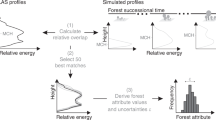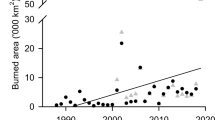Abstract
We describe a model of forest flammability, based on daily satellite observations, for national to regional applications. The model defines forest flammability as the percent moisture content of fuel, in the form of litter of varying sizes on the forest floor. The model uses formulas from the US Forest Service that describe moisture exchange between fuel and the surrounding air and precipitation. The model is driven by estimates of temperature, humidity, and precipitation from the moderate resolution imaging spectrometer and tropical rainfall measuring mission multi-satellite precipitation analysis. We provide model results for the southern Amazon and northern Chaco regions. We evaluate the model in a tropical forest-to-woodland gradient in lowland Bolivia. Results from the model are significantly correlated with those from the same model driven by field climate measurements. This model can be run in a near real-time mode, can be applied to other regions, and can be a cost-effective input to national fire management programs.








Similar content being viewed by others
References
Albini FA (1979) Spot distance from burning trees—a predictive model. USDA Forest Service general technical report INT-56. Intermountain forest and range experiment station, Forest Service, US Department of Agriculture, Ogden, Utah, USA
Albini FA (1985) A model for fire spread in wildland fuels by radiation. Combust Sci Technol 42:229–258
Anderson H (1982) Aids to determining fuel models for estimating fire behavior. USDA Forest Service general technical report INT-122. Intermountain Forest and Range Experiment Station, Forest Service, US Department of Agriculture, Ogden, Utah, USA
Bradshaw LS, Deeming JE, Burgan RE, Cohen JD (1984) The 1978 national fire-danger rating system: technical documentation. General technical report INT-169. US Intermountain Forest and Range Experiment Station, Forest Service, US Department of Agriculture, Ogden, Utah, USA
Brown JK (2000) Wildland fire in ecosystems: effects of fire on flora. USDA Forest Service general technical report Gen. Tech. Rep. RMRS-GTR-42-vol 2. Ogden, UT: US Department of Agriculture, Forest Service, Rocky Mountain Research Station, US Department of Agriculture Ogden, UT, USA
Burgan RE, Andrews PL, Bradshaw LS, Chase CH, Hartford RA, Latham DJ (1997) WFAS: wildland fire assessment system. Fire Manag Notes 57(2):14–17
Burgan RE, Klaver RW, Klaver JM (2000) Fuel models and fire potential from satellite and surface observations. http://www.fs.fed.us/land/wfas/firepot/fpipap.htm. Accessed online 8 Apr 2009
Burgen RE (1979) Estimating live fuel moisture for the 1978 national fire danger rating system. USDA Forest Service research paper INT-226. Intermountain Forest and Range Experiment Station, Forest Service, US Department of Agriculture, Ogden, Utah, USA
Byram GM (1959) Combustion of forest fuels. In: Davis KP (ed) Forest fire control and use, 2nd edn. McGraw-Hill Book Company, New York, pp 113–126
Cardoso MF, Hurtt GC, Moore B III, Nobre CA, Prins EM (2003) Projecting future fire activity in Amazonia. Glob Change Biol 9:656–669
Chen Y, Randerson JT, Morton DC, DeFries RS, Collatz GJ, Kasibhatla PS, Giglio L, Jin Y, Marlier ME (2011) Forecasting fire season severity in South America using sea surface temperature anomalies. Science 334:787–791
Chuvieco E, Cocero D, Riaño D, Martin P, Martínez-Vega J, de la Riva J, Pérez F (2004) Combining NDVI and surface temperature for the estimation of live fuel moisture content in forest fire danger rating. Remote Sens Environ 92:322–331
Cohen JD, Deeming J (1985) The national fire danger rating system: basic equations. US Forest Service technical report PSW-82. Pacific Southwest Forest Range Experimental Station, Berkeley, California, USA
Dinku T, Ceccato P, Grover-Kopec E, Lemma M, Connor SJ, Ropelewski CF (2007) Validation of satellite rainfall products over East Africa’s complex topography. Int J Remote Sens 28:1503–1526
Ebert EE (2005) Satellite versus model rainfall—Which one to use? Fifth international scientific conference on the global energy and water cycle, Orange County. Global Energy and Water Experiment. http://www.gewex.org/5thConfposterT6-7_Ebert.pdf. Accessed 9 Mar 2009
Fosberg MA (1971) Moisture content calculations for the 100-h timelag fuel in fire danger rating. US Department of Agriculture Forest Service Research Note RM-199. US Department of Agriculture Forest Service, Rocky Mountain Forest and Range Experiment Station, Fort Collins, Colorado, USA
Fosberg MA (1977) Forecasting the 10-h timelag fuel moisture. USDA Forest Service research paper RM-187. Rocky Mountain Forest and Range Experiment Station, Fort Collins, Colorado, USA
Fosberg MA, Rothermel RC, Andrews PL (1981) Moisture content calculations for 1,000-h timelag fuels. For Sci 27:19–26
GADSC (2013) Autonomous government of the Department of Santa Cruz in partnership with FAN implements climate change program. Webpage of the Gobierno Autonimo Departmental de Santa Cruz (GADSC), Bolivia. http://www.santacruz.gob.bo/turistica/medioambiente/cambioclimatico/contenido.php?IdNoticia=3409&IdMenu=30044. Accessed 30 Jan 2013
Goetz SJ, Prince SD, Goward SN, Thawley MM, Small J, Johnston A (1999) Mapping net primary production and related biophysical variables with remote sensing: applications to the Boreas region. J Geophys Res 104:27,719–727,734
Goetz SJ, Bunn AG, Fiske GJ, Houghton RA (2005) Satellite-observed photosynthetic trend across boreal North America associated with climate and fire-disturbance. Proc Natl Acad Sci 102:13521–13525
Grégoire JM, Tansey K, Silva JMM (2003) The GBA2000 initiative: developing a global burned area database from SPOT-VEGETATION imagery. Int J Remote Sens 24:1369–1376
Hansen M, DeFries RS, Townshend JRG, Carroll M, Dimiceli C, Sohlberg RA (2003) Global percent tree cover at a spatial resolution of 500 meters: first results of the MODIS vegetation continuous fields algorithm. Earth Interact 7:1–15
Heinsch FA, Andrews PL (2010) BehavePlus fire modeling system, version 5.0: Design and features. General technical report RMRS-GTR-249. Fort Collins: US Department of Agriculture, Forest Service, Rocky Mountain Research Station. (10,487 KB; p 111)
Hirpa FA, Gebremichael M (2010) Evaluation of high-resolution Satellite precipitation products over very complex terrain in Ethiopia. J Appl Meteorol Climatol 29:1044–1051
Huffman GJ, Adler RF, Bolvin DT, Gu G, Nelkin EF, Bowman KP, Hong Y, Stocker EF, Wolff DB (2007) The TRMM multisatellite precipitation analysis (TMPA): quasi-global, multiyear, combined-sensor precipitation estimates at fine scales. J Hydrometeorol 8:38–55
Illera P, Fernández A, Delgado JA (1996) Temporal evolution of the NDVI as an indicator of forest fire danger. Int J Remote Sens 5(17):1093–1105
INPE (2013) Fire Monitoring Program, Instituto Nacional de Pesquisas Espaciais, Brazil. http://pirandira.cptec.inpe.br/queimadas/#. Accessed 23 Jan 2013
INPE-Instituto Nacional de Pesquisas Espaciais (2011) Portal do Monitoramento de Queimadas e Incêndios. Disponível em. http://www.inpe.br/queimadas. Accessed 30 Nov 2011
Justice CO, Giglio L, Korontzi S, Owens J, Morisette JT, Roy D, Descloitres J, Alleaume S, Petitcolin F, Kaufman Y (2002) The MODIS fire products. Remote Sens Environ 83:244–262
Katsanos D, Lagouvardos K, Kotroni V, Huffman GJ (2004) Statistical evaluation of MPA-RT high-resolution precipitation estimates from satellite platforms over the central and eastern Mediterranean. Geophys Res Lett 31:L06116. doi:10.1029/2003GL019142
Keetch J, Byram GM (1968) A drought index for forest fire control. USDA Forest Service research paper SE-38. US Department of Agriculture-Forest Service, Ashville, NC, USA
Killeen TJ, Chavez E, Peña-Claros M, Toledo M, Arroy L, Caballero J, Correa L, Guillén R, Quevedo R, Saldias M, Soria L, Uslar Y, Vargas I, Steininger M (2006) The Chiquitano dry forest, the transition between humid and dry forest in Eastern lowland Bolivia. In: Pennington T, Lewis GP, Ratter JA (eds) Neotropical savannas and dry forests: plant diversity, biogeography and conservation. Taylor & Francis, London, p 213–234
Kummerow C, Simpson J, Thiele O, Barnes W, Chang ATC, Stocker E, Adler RF, Hou A, Kakar R, Wentz F, Ashcroft P, Kozu T, Hong Y, Okamotok Iguchi T, Kuroiwa H, Im E, Haddad Z, Huffman G, Ferrier B, Olson WS, Zipser E, Smith EA, Wilheit TT, North G, Krishnamurti T, Nakamura K (2000) The status of the tropical rainfall measuring mission (TRMM) after 2 years in orbit. J Appl Meteorol 39:1965–1982
Lewis SL, Brando PM, Phillips OL, van der Heijden GMF, Nepstad D (2011) The 2010 Amazon drought. Science 331:554
Machado, LAT, Ceballos J (2000) Satellite based products for monitoring weather in South America: winds and trajectories. 5th international winds workshop, Saannenmoser
Matson M, Holben B (1987) Satellite detection of tropical burning in Brazil. Int J Remote Sens 8:509–516
Monteith JL, Unsworth MH (1990) Principles of environmental physics, 2nd edn. Edward Arnold Publishers, New York
Myneni RB, Hoffman S, Knyazikhin Y, Privette JL, Glassy J, Tian Y, Wang Y, Song X, Zhang Y, Smith GR, Lotsche A, Friedl M, Morisette JT, Votava P, Nemani RR, Running SW (2002) Global products of vegetation leaf area and fraction absorbed PAR from year one of MODIS data. Remote Sens Environ 83:214–231
Nepstad D, Lefebvre P, da Silva UL, Tomasella J, Schlesinger P, Solorzano L, Moutinho P, Ray D, Benito JG (2004) Amazon drought and its implications for forest flammability and tree growth: a basin-wide analysis. Glob Change Biol 10:704–717
NWCG (2013) National wildfire coordinating group (NWCG), Glossary of wildland fire terminology. http://www.nwcg.gov/pms/pubs/glossary/f.htm. Accessed 30 Jan 2013
Onset (2012) http://www.onsetcomp.com/products. Accessed 20 Feb 2012
Palmer WC (1965) Meteorological drought. US Department of Commerce research paper no. 45. US government printing office, Washington, DC, USA
Phillips OL, Aragão LEOC, Lewis SL, Fisher JB, Lloyd J, López-González G, Malhi Y et al (2009) Drought sensitivity of the Amazon rainforest. Science 323:1344–1347
Prince SD, Goward SN (1995) Global primary production: a remote sensing approach. J Biogeogr 22:815–835
Rainwise (2012) http://www.rainwise.com/products/index.php?Category=Rain_Gauges:Wired. Accessed 20 Feb 2012
Ray D, Nepstad D, Moutinho P (2005) Micrometeorological and canopy controls of fire susceptibility in a forested amazon landscape. Ecol Appl 15:1664–1678
Roy DP, Lewis PE, Justice CO (2002) Burned area mapping using multi-temporal moderate spatial resolution data- a bi-directional reflectance mode-based expectation approach. Remote Sens Environ 83:263–286
Running SW, Nemani RR, Heinsch FA, Zhao M, Reeves M, Hashimoto H (2004) A continuous satellite-derived measure of global terrestrial primary production. Bioscience 56:547–560
Schroeder MJ (1969) Ignition probability. Office report 2106-1. US Department of Agriculture Forest Service, Rocky Mountain Forest and Range Experiment Station, Fort Collins, Colorado, USA
Scott JH, Burgan RE (2005) Standard fire behavior fuel models: a comprehensive set for use with Rothermel’s surface fire spread model. General technical report RMRS-GTR-153. US Department of Agriculture Forest Service, Rocky Mountain Forest and Range Experiment Station, Fort Collins, Colorado, USA
Seemann SW, Li J, Menzel WP, Gumley LE (2003) Operational retrieval of atmospheric temperature, moisture, and ozone from MODIS infrared radiances. J Appl Meteorol 42:1072–1091
Seemann SW, Borbas EE, Li J, Menzel WP, Gumley LE (2006) MODIS atmospheric profile retrieval algorithm theoretical basis document version 6. http://modis.gsfc.nasa.gov/data/atbd/atbd_mod07.pdf. Accessed 1 Jun 2009
Setzer AW, Sismanoglu RA (2009) Fire risk: summary of calculations. INPE. http://www.cptec.inpe.br/queimadas/documentos/doc_RF_2007.pdf. Accessed 9 Apr 2009
USFS (2013) US Forest Service Wildland Fire Assessment System. http://www.wfas.net. Accessed 23 Jan 2013
USGS (2004) Shuttle radar topography mission, 3 arc second scene SRTM_u03_n008e004, Unfilled Unfinished 2.0, Global Land Cover Facility, University of Maryland, College Park, Maryland, February 2000
Wan Z (2009) MODIS land surface temperature products users’ guide. http://www.icess.ucsb.edu/modis/LstUsrGuide/MODIS_LST_products_Users_guide.pdf. Accessed 6 Apr 2009
Wan Z, Li Z-L (1997) A physics-based algorithm for retrieving land-surface emissivity and temperature from EOS/MODIS data. IEEE Trans Geosci Remote Sens 35:980–996
Wan Z, Zhang Y, Zhang Q, Li Z-L (2004) Quality assessment and validation of the MODIS global land surface temperature. Int J Remote Sens 25:261–274
Wang J, Wolff DB (2010) Evaluation of TRMM ground-validation radar-rain errors using rain gauge measurements. J Appl Meteorol Climatol 49:310–324
Wang W, Liang S, Meyers T (2007) MODIS land surface temperature products using long-term nighttime ground measurements. Remote Sens Environ 112:623–635
Acknowledgments
This study was supported by a Grant from the National Aeronautics and Space Administration (NASA Grant # NAG13-02008). We thank Geoffrey Blate for his support in compiling the field data, George Huffman and Louis Giglio for providing expert advice during the development of this model, Tim Killeen and the Museo Noel Kempff Mercado for logistical support, the Fundacion Amigos de la Naturaleza (FAN), the Bolivia Forestry project (BOLFOR), and Wildlife Conservation Society (WCS) for access to field sites.
Author information
Authors and Affiliations
Corresponding author
Appendix
Rights and permissions
About this article
Cite this article
Steininger, M.K., Tabor, K., Small, J. et al. A Satellite Model of Forest Flammability. Environmental Management 52, 136–150 (2013). https://doi.org/10.1007/s00267-013-0073-1
Received:
Accepted:
Published:
Issue Date:
DOI: https://doi.org/10.1007/s00267-013-0073-1




